While pitching a camping tent is quite easy, folding it after usage can be somewhat tricky. Despicably folded outdoors tents are the most-loved breeding arena for molds. Additionally, a badly packed outdoors tent can create wrinkles which may bring about extreme damage to the material used in making the tent.
Once you have unloaded a tent, it is extremely hard to get everything back in its backpack. That is where the question of “how to fold a tent” comes in. You need to know the proper ways to fold a tent so that it can go into its bag easily without much stress.
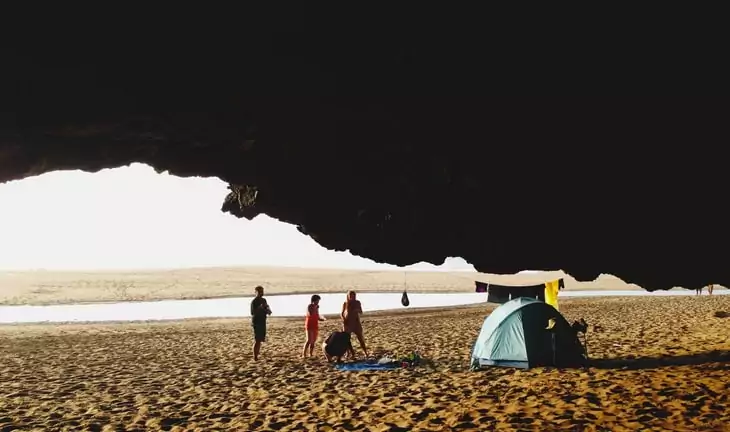
While there are many tents types, in this article, we will try and examine several tips on the most proficient way to pack away some of them in view of the most frequently utilized ones.
Why You Need to Know the Proper Way to Fold a Tent
Tents are not extremely cheap, and if you need something that you can set up faster and make you pretty much comfortable even on just a night camping, you will certainly need to put resources into something that is perfect in order to give you adequate comfort and protection. While many battles with just setting up a tent, the majority are not aware that figuring out how to properly fold it can be absolutely necessary.
To keep away from incidentally detaching the materials, or folding it superfluously, knowing how to fold the tent can, and also makes it less demanding to convey particularly when hiking or trekking. A badly folded tent can feel bulkier and heavier, due to the unequal weight distribution. While this may not appear to mean much amid the first 10mins of conveying, you will see the changes after walking with it in the first hour.
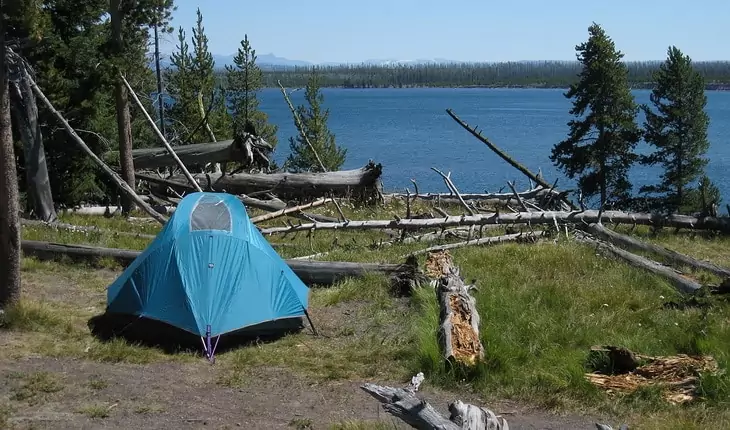
Camping is adventurous and fun. What is there that is not lovable when you are observing nature? Camping events are likewise an awesome approach to have a reasonable nature encounter. You need to maximize the fun by folding and moving your camping tent to your campsite. When you consider going on moderate outings, you surely would prefer not to burn through cash on purchasing outdoors tents or gear. In this light, see our important reviews on the best ultraweight tents that you can choose from for your next adventure.
If you already are in possession of a tent, you will need to take it along with you to your campsite, if you are planning on camping in that area. The most effortless way to do as such is to pack and move your tent. You can effortlessly pack away and move your tent to your campground. In the next segment of the article, we will disclose to you the proper way to fold a tent for easy movement. Though there are diverse types of tents, we are going to explain how to fold each of them.
Breaking Down Your Tent After Use
When packing your tent after use, the most critical factor to take note is that it should be is dry and free from any form of debris. If your tent is wet, at the campsite you may pack it up and store it for a while, but within the period of 24 hours, it should be thoroughly dried. You can hang it some place to dry or place it somewhere in your home to dry. When the tent is totally dry, lay it flat on the floor with the base on the lower ground. Take the sack and lay the tent out on either side. This will fill in as a manual to let you know to what extent the folds of your camping tent ought to be.
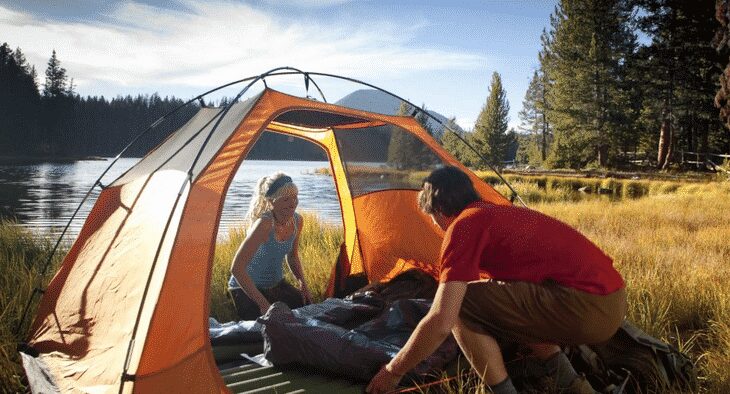
Family tents can be packed anyhow, however, it is simpler to overlap it in thirds or quarters contingent upon the stuff pack’s length. Overlap your fly and place it longwise on the tent. Pack the tent on that in order for you to have the fly within the tent’s fold. Put the tent poles in their bag, drop the stake pack into the pole bag and place the entire thing over the folded tent. Move it up firmly, beginning with the tent poles. Roll gradually, drawing the air from the tent. Done appropriately the entire tent ought to drop inside your bag.
Materials Needed for folding a Tent
Listed below are the rundown of materials required for folding a tent:
- Pincers: for breaking the tent
- Cardboard Box: for tent packing
- Plastic Pouches: for packing the backups
- Foam: for inward padding of the cardboard box
- Bubble Wraps: for protecting each part
- Packing Peanuts: for inward padding of the cardboard box
- Duct Tape: for closing the box
- Ropes: for tying things

Folding a Camping/Backpacking Tent
- Step one: Clean before Folding. Before you begin to fold outdoors tent, evacuate things in the tent and then utilize a sodden cloth to wipe the inner parts of the tent. Make sure you take off all food crumbs and debris that can welcome molds to develop. After you have finished wiping the inner parts of your tent, wipe out the outside also. You have to dry the tent before folding it. Do not try to fold the tent when it is sodded or wet. Keep in mind that damp regions are most-loved reproducing arena of molds so as to ensure that your tent is totally dry before you fold it.
- Step two: Remove the Stakes. Once your tent is dry and clean, take off the pins or stakes that hold the tent to the floor. Put the pins and stakes in a little sack or package them together with a bit of little rope or twine and keep them in your rucksack. Do not put the pins and stakes inside the pack holding your tent to the ground. Keep in mind that pins and stakes are sharp tools so they can create holes in your tent materials.
- Step three: Remove the Tent Poles. To take off the poles, just haul them out from the circles of your tent and overlay them appropriately. If the poles of your tent are divided or have distinctive segments that matches each other to make long poles, evacuate the fitted areas and keep them in the pole sack.
- Step four: Shake the Tent. After taking off the tent poles, get the tent and give it a decent shake to evacuate every debris sticking to it.
- Step five: Pull the Tent Flat on the Ground Place the tent on the campground and draw it till it lays level. Check the base side of your tent and ensure that it is totally dry. If the base of the tent is still moist, utilize a dry cloth to wipe the dampness, then dry the tent for no less than 20mins.
- Step six: Fold the Tent. When you try to fold a tent, lift the exterior part of the tent toward the center, ensuring that the tent folds are in line with each other. You have to overlay the tent longwise. When folding, ensure that the entryway remains on top of the overlap. Subsequent to folding the tent longwise, make sure you pat the folded tent part in order to discharge the air trapped in it.
- Step seven: Roll and Store. Subsequent to discharging the air trapped in the tent, carefully roll the tent beginning from the end extremely far from the entryway and then work up your way. After that, tie the tent recently rolled up with twine, and then put it in your tent sack.
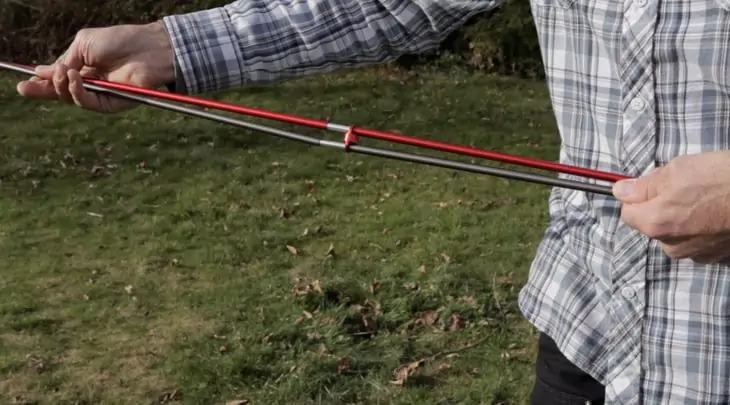
Folding A Cabin Tent
Cabin tents usually come in many shapes and sizes. Traditional ones utilize heavyweight canvas and unbending aluminum shafts to make an expansive living room. The traditional tents have just one large space together with standing room and the choice for a cooking stove. The majority of the present day style have a few rooms, nylon outsides, and collapsible tent poles.
The traditional ones are designed to withstand intense winds, snow, and moisture. The modern outlines are substantially lighter compared to traditional ones. It is pretty much easy to dismantle a cabin tent. The issue now is setting up a tent and fitting it again into the tent bag.
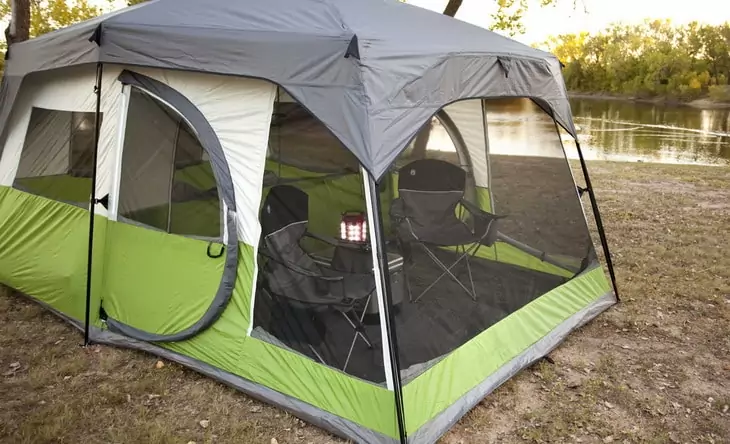
A cabin tent is substantially greater compared to the regular ones, and can definitely fit around ten individuals, perhaps more. The capacity sack that accompanies the tents are intended to be space proficient, and it will be an exceptionally cozy fit. There is not really any space for blunders when stuffing a tent back in. Here are the steps to follow when folding or packing away a cabin tent:
- Step one: Keep in mind to wipe both the inward and external materials of the cabin tent with a cleaning cloth before you begin dismantling the tent so as to dispose of any moisture or dirt.
- Step two: Evacuate the tent stakes and poles.
- Step three: Lay flat the tent on a level ground so as to form either a square or a rectangle, contingent upon your tent’s style.
- Step four: Fold the cabin tent into half, and cover up any batching and lumping as much as could be expected, so that the tent may lay flat on the ground.
- Step five: Fold the tent in a similar heading into the half once more, so as to form a longwise rectangle. Cover up any wrinkles and bumps as much as could be expected.
- Step six: You should check out the length of the tent’s storage sack. The breadth of your already folded tent ought to be less in size than storage sack’s length. In the event that it still more, fold the tent again in a similar direction, covering the lines as much as could be expected.
- Step seven: Begin at the thin end, firmly roll up the tent and push it in the tent’s storage sack and that’s all!
Folding A Dome Type Tent
Going outdoors with friends and families in the backwoods, on the shoreline or in your backyard are great ways to appreciate the game. While folding a dome type tent is quite simple, you will have to figure out how to make each fold and also how to store them after the folding process. Similarly, as with the same with fabric, it is very imperative to stick to the producer’s directions.
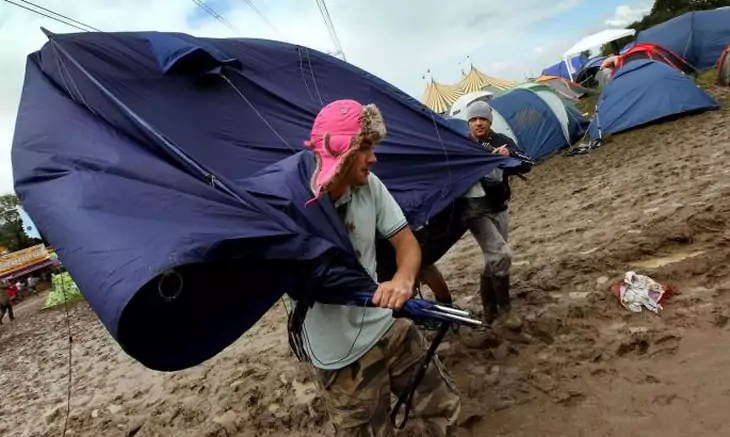
Here are the steps to follow when folding a dome type tent:
- Step one: Flysheet must be folded. The covering sheet of a tent is always known as flysheet. Begin the process by evacuating the tent’s shafts and afterward overlap it the lengthwise. The main reason behind this is to enable the ropes on the flysheet to wind up folded inward and not outward. You should fold both the flysheet’s ends, thereby, making them very compactible and folding them inward towards the middle as much as could reasonably be expected. After you have concluded the process, fold it over yet again. And then carefully and firmly move up the flysheet and afterward tie it up.
- Step two: Roll up the flysheet. Start at the top part of the flysheet, particularly the lightest segment, which is possibly also the area that is in the middle part of the rooftop. Roll it up very well and after that tie it up. The more tightly the flysheet is rolled, the less demanding it will be definitely to put it inside the backpack.
- Step three: Fold the main tent. Begin by laying out the tent’s main body in a similar way as when it is raised. Ensure that all tent’s zippers are done, for the entryway as well as for the windows and some other zip that may also be there.
- Step four: Set the roof portion. Use the inside rooftop mounts, for example, tubes and clips for the support rods. To keep the shade from being excessively bundled up, draw the shade in order for it to lie flat. Give careful consideration to the entryway, and ensure that it is flat. There will be overabundance material, but don’t stress over it, you simply need to lay it on the back entryway parcel. In the event that your tent has no vestibule, you need to be working in a roundabout heading, drawing each side firmly and winding up with the front end. It will surely help if your camping tent is still safe while doing this process.
- Step five: Fold the vestibule. If your camping tent has no vestibule, you can overlook this process and continue with the next. Fold the vestibule in order for it to lay over the tent’s main body, ensuring that the top segment will lie on top of the tent.
- Step six: Fold the tent: Fold every side towards the middle part of the tent, and then fold it in half again in order for you to wind up with a fourth of the tent’s real size.
- Step seven: Assemble everything.
Begin to pile everything on the front segment of the tent. The ideal approach in doing this is to lay down the flysheet to start with, and then the tent poles, pegs and after that every other segment. The main trick here is to include one thing in, roll it once, add another thing and roll once more. Just continue doing this process until parts are securely tucked inside it. Roll the tent’s end and tie it safely. Ensure that you roll up the tent firmly and safely. Maintain a strategic distance from irrelevant wrinkles as this can take into consideration additional air rooms which will definitely make it impossible to be placed inside the bag.
You can even make a DIY backpacking with your family if you’re on a tight budget.
Storing Your Tent After Folding and Packing
Before storing your camping tent after folding, there are a few approaches to take in order to ensure that you receive the most in return. Ensure that you open up the tent and carefully wipe it off. This may appear like a disturbance – particularly in case you’re drained and worn down after an outdoor trip – but if you store a dirty tent, damp and mold will settle in, bringing about hostile scents and this tends to ruin it permanently.
If you know that your tent was on moisty campground, try to give it a chance to dry before taking off. If that is impossible for you, remove it from the pack when you return home and spread it out on a level surface or place it on a hanger in order for it to dry out very well. Ensure that you don’t abandon your tent beside a fire source as it can destroy the material and most likely set the tent ablaze.
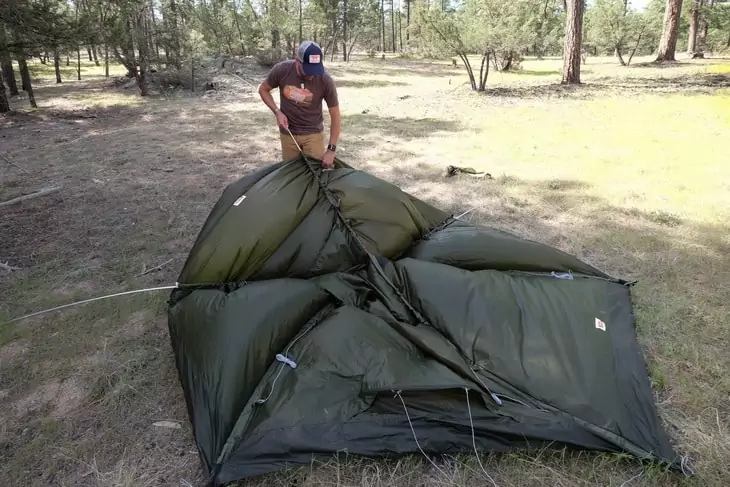
Additionally, abandoning it in direct sunlight can bring about unsalvageable damage. Locate a cool, dry place to keep your tent because it will help you to maintain a strategic distance from damp and mildew in your tent. Spread the tent on the level ground as standing it on end can make the tent poles to penetrate the thin material used in making the tent.
As specified above, before storing your tent, it ought to be 100% aired and dry. If you park off while it is still soggy, damp and mold will develop on the canvas and thereby leaving it with a bad smell – in addition, to the mold can likewise destroy the waterproof covering on the tent’s skin.
After folding and packing, try to always keep your camping tent in a cool, dry place, that does not get to be too warm as a result of the sun. A cupboard shelf in the house would be much better compared to the garden shed. While your tent is kept, ensure it is stuffed freely in order to give the air a chance to flow and keep a stale odor from erupting.
Catch up on your reading by checking out our topic on tarp tent setups to give you more options when camping.
Concluding Thoughts on This Topic
We believe this article has propelled you to fold or pack away your tent for your next outdoor trip. Just in case you still have any questions or doubts as regards to folding your tent, we are always available to assist you.
Here are more tips and guidelines on how to take care of your tent – check it out.
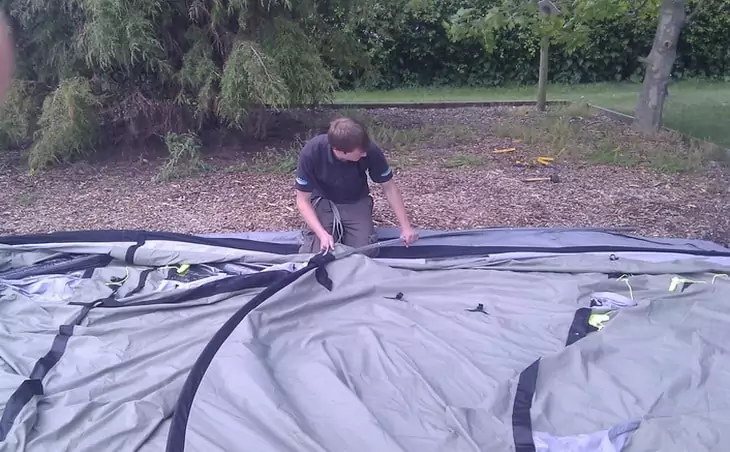
Don’t hesitate to reach us! Tell us what you think and leave any suggestions or comments below. We would love to hear it from you and any other amazing trick you may have for us as regards to folding a tent. Not all strategies are effective for everybody, so the more alternatives we have, the more the fun!

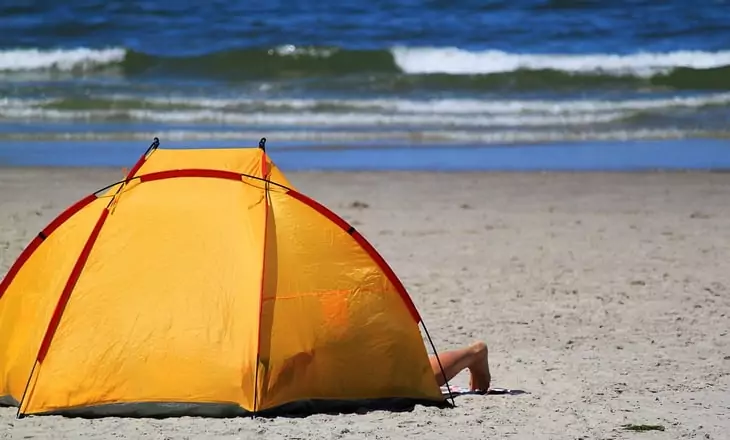





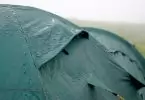
A simple skill such as folding your camping tent can save you money and backpacking space. So, never give up even if you do it wrong the first time.
That’s right, Luis. And you should never fail with step 1 (cleaning), because it is the most important step of all.